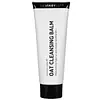What's inside
What's inside
 Key Ingredients
Key Ingredients

 Benefits
Benefits

 Concerns
Concerns

 Ingredients Side-by-side
Ingredients Side-by-side

Prunus Amygdalus Dulcis Oil
Skin ConditioningCetearyl Alcohol
EmollientPEG-6 Caprylic/Capric Glycerides
EmulsifyingAvena Sativa Kernel Oil
Skin ConditioningCandelilla Cera
EmollientSilica
AbrasiveSorbitan Stearate
EmulsifyingTribehenin
EmollientPEG-60 Almond Glycerides
EmulsifyingAvena Sativa Kernel Flour
AbrasiveWater
Skin ConditioningBenzyl Alcohol
PerfumingPhenoxyethanol
PreservativeLecithin
Emollient1,2-Hexanediol
Skin ConditioningAscorbyl Palmitate
AntioxidantTocopherol
AntioxidantBiosaccharide Gum-4
Skin ConditioningHelianthus Annuus Seed Oil
EmollientPrunus Amygdalus Dulcis Oil, Cetearyl Alcohol, PEG-6 Caprylic/Capric Glycerides, Avena Sativa Kernel Oil, Candelilla Cera, Silica, Sorbitan Stearate, Tribehenin, PEG-60 Almond Glycerides, Avena Sativa Kernel Flour, Water, Benzyl Alcohol, Phenoxyethanol, Lecithin, 1,2-Hexanediol, Ascorbyl Palmitate, Tocopherol, Biosaccharide Gum-4, Helianthus Annuus Seed Oil
Caprylic/Capric Triglyceride
MaskingGlyceryl Behenate
EmollientOlea Europaea Leaf Water
Skin ConditioningSimmondsia Chinensis Seed Oil
EmollientOctyldodecanol
EmollientPolyglyceryl-10 Caprylate
EmulsifyingJojoba Esters
EmollientOlea Europaea Fruit Oil
MaskingHydrogenated Vegetable Oil
EmollientGlyceryl Stearate
EmollientHelianthus Annuus Seed Wax
Skin ConditioningWater
Skin ConditioningGlycerin
HumectantGlycolipids
Skin ConditioningAcacia Decurrens Flower Wax
EmollientQuillaja Saponaria Wood Extract
Skin ConditioningSaponaria Officinalis Leaf/Root Extract
Skin ConditioningBeta Vulgaris Root Extract
Skin ConditioningCichorium Intybus Root Extract
MaskingMalva Sylvestris Flower/Leaf Extract
Skin ConditioningPapaver Rhoeas Flower Extract
Skin ConditioningPortulaca Oleracea Extract
Skin ConditioningLamium Album Leaf Extract
Skin ConditioningUrtica Dioica Leaf Extract
Skin ConditioningChamomilla Recutita Flower Extract
MaskingMichelia Alba Leaf Oil
MaskingFraxinus Excelsior Bark Extract
Skin ConditioningSaccharomyces Ferment Lysate Filtrate
Skin ConditioningHelianthus Annuus Seed Oil
EmollientPolyglycerin-3
HumectantSqualane
EmollientLactobacillus Ferment
Skin ConditioningTocopherol
AntioxidantSodium Benzoate
MaskingPotassium Sorbate
PreservativeP-Anisic Acid
MaskingCitric Acid
BufferingLinalool
PerfumingCaprylic/Capric Triglyceride, Glyceryl Behenate, Olea Europaea Leaf Water, Simmondsia Chinensis Seed Oil, Octyldodecanol, Polyglyceryl-10 Caprylate, Jojoba Esters, Olea Europaea Fruit Oil, Hydrogenated Vegetable Oil, Glyceryl Stearate, Helianthus Annuus Seed Wax, Water, Glycerin, Glycolipids, Acacia Decurrens Flower Wax, Quillaja Saponaria Wood Extract, Saponaria Officinalis Leaf/Root Extract, Beta Vulgaris Root Extract, Cichorium Intybus Root Extract, Malva Sylvestris Flower/Leaf Extract, Papaver Rhoeas Flower Extract, Portulaca Oleracea Extract, Lamium Album Leaf Extract, Urtica Dioica Leaf Extract, Chamomilla Recutita Flower Extract, Michelia Alba Leaf Oil, Fraxinus Excelsior Bark Extract, Saccharomyces Ferment Lysate Filtrate, Helianthus Annuus Seed Oil, Polyglycerin-3, Squalane, Lactobacillus Ferment, Tocopherol, Sodium Benzoate, Potassium Sorbate, P-Anisic Acid, Citric Acid, Linalool
 Reviews
Reviews

Ingredients Explained
These ingredients are found in both products.
Ingredients higher up in an ingredient list are typically present in a larger amount.
Helianthus Annuus Seed Oil is the oil derived from the seeds of a Sunflower. Sunflower seed oil is non-fragrant. It is an emollient, meaning it helps to soften the skin.
Sunflower seed oil contains many fatty acids. The fatty acids found in sunflower seeds include (from highest amount to least): linoleic acid, myristic acid, palmitic acid, stearic acid, arachidic acid, oleic acid, and linolenic acid.
These fatty acids help the skin create ceramides. Ceramides play a role in repairing the skin barrier.
Helianthus Annuus Seed Oil helps moisturize the skin. This in turn helps the skin look more rejuvenated and smoother.
Sunflowers are rich in vitamin E.
Historians believe Indigenous cultures of North America domesticated sunflowers before corn. Thus they relied on sunflower oil for a variety of uses. One such use is moisturizing skin and hair.
Sunflower seed oil may not be fungal acne safe. We recommend speaking with a professional if you have any concerns.
Learn more about Helianthus Annuus Seed OilTocopherol (also known as Vitamin E) is a common antioxidant used to help protect the skin from free-radicals and strengthen the skin barrier. It's also fat soluble - this means our skin is great at absorbing it.
Vitamin E also helps keep your natural skin lipids healthy. Your lipid skin barrier naturally consists of lipids, ceramides, and fatty acids. Vitamin E offers extra protection for your skin’s lipid barrier, keeping your skin healthy and nourished.
Another benefit is a bit of UV protection. Vitamin E helps reduce the damage caused by UVB rays. (It should not replace your sunscreen). Combining it with Vitamin C can decrease sunburned cells and hyperpigmentation after UV exposure.
You might have noticed Vitamin E + C often paired together. This is because it is great at stabilizing Vitamin C. Using the two together helps increase the effectiveness of both ingredients.
There are often claims that Vitamin E can reduce/prevent scarring, but these claims haven't been confirmed by scientific research.
Learn more about TocopherolWater. It's the most common cosmetic ingredient of all. You'll usually see it at the top of ingredient lists, meaning that it makes up the largest part of the product.
So why is it so popular? Water most often acts as a solvent - this means that it helps dissolve other ingredients into the formulation.
You'll also recognize water as that liquid we all need to stay alive. If you see this, drink a glass of water. Stay hydrated!
Learn more about Water